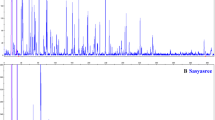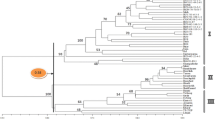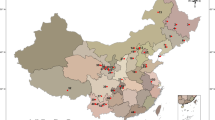Abstract
To assess diversification of indica rice, fingerprinting of 42 Indian rice varieties (Oryza sativa L) and one accession of O. brachyantha Chev. et Roehr. was taken up using amplified fragment length polymorphism (AFLP). Six primer combinations of PstI and MseI were used for this purpose. On denaturing polyacrylamide sequencing gel, on average 41 scorable AFLP bands were obtained of which 81% were polymorphic. Each variety revealed a distinct fingerprint. Data were scored on the basis of presence and absence of bands and cluster analysis was performed using Dice similarity coefficients. The resultant dendrogram showed four major clusters and traits. Some varieties especially landraces revealed more polymorphism and unique loci. Such study will be a valuable tool for proper choice of parents in mapping populations or breeding programs to produce heterotic several inexplicable minor clusters. Some varieties were grouped according to parentages of the cross while some were grouped according to physiological combinations apart from providing a characteristic fingerprint.
Similar content being viewed by others
References
Chauhan, J.S. & V.S. Chauhan, 1994. Genetic divergence in rainfed upland rice (Oryza sativa L.) Ores 31: 103–106.
Dellaporta, S.L., J. Wood & J.B. Hick, 1983. A plant DNA mini preparation; Version II. Plant Mol. Biol. Rep. 1: 19–21.
Folkertsma, R.T., J.N.A.M. Rouppe vander Voort, K.E. de Groot, P.M. van Zandvoort, A. Schots, F.J. Gommers, J. Helder & J. Bakker, 1996. Gene pool similarities of potato cyst nematode populations assessed by AFLP analysis. MIPMI 9: 47–54.
Fukuoka, S., K. Hosaka & O. Kamijima, 1992. Use of random amplified polymorphic DNAs (RAPDs) for identification of rice accessions. Jpn. J. Genet. 67: 247–252.
Ghareyazie, B., N. Huang, G. Second, J. Bennett & G.S. Khush, 1995. Classification of rice germplasm 1. Analysis using ALP and PCR-based RFLP. Theor. Appl. Genet. 91: 218–227.
Janssen, P., R. Coopman, G. Huys, J. Swings, M. Bleeker, P. Vos, M. Zabeau & K. Kersters, 1996. Evaluation of the DNA fingerprinting method AFLP as a new tool in bacterial taxonomy. Microbiology 142: 1881–1893.
Mackill, D.J., 1995. Classifying japonica rice cultivars with RAPD markers, Crop Sci. 35: 889–894.
Maheswaran, M., P.K. Subudhi, S. Nandi, J.C. Xu, A. Parco, D. Yang & N. Huang, 1996. Polymorphism, distribution, and segregation of AFLP markers in a doubled haploid population of rice. Theor. Appl. Genet. (in press).
Nei, M. & N.H. Li, 1979. Mathematical model for studying genetic variation in terms of restriction endonucleases. Proc. Natl. Acad. Sci. U.S.A. 74: 5267–5273.
Nei, M., 1987. Molecular Evolutionary Genetics, Columbia University Press, NY, pp. 106–107.
Ramakrishna, W., M.D. Lagu, V.S. Gupta & P.K. Ranjekar, 1994. DNA fingerprinting in rice using oligonucleotide probes specific for simple repetitive DNA sequences. Theor. Appl. Genet. 88: 402–406.
Ramakrishna, W., K.D. Chowdari, M.D. Lagu, V.S. Gupta & P.K. Ranjekar, 1995. DNA fingerprinting to detect genetic variation in rice using hypervariable DNA sequences. Theor. Appl. Genet. 90: 1000–1006.
Rohlf, F.J., 1990. NTSYS-PC Manual Version 1.70. Exter Software, Setauket, NY.
Virk, P.S., H.J. Newbury, M.T. Jackson & B.V. Ford-Lloyed, 1995.The identification of duplicate accessions within a rice germplasm collection using RAPD analysis. Theor. Appl. Genet. 90: 1049–1055.
Vos, P., R. Hoggers, M. Becker, M. Rejans, T. Lee, M. Hornes, P.J. Friejtera, J. Peleman, M. Kuiper & M. Zabeau, 1995. AVLP; a new technique for DNA fingerprinting. Nucleic Acids Res. 23: 4407–4414.
Wang, Z.Y. & S.D. Tanksley, 1989. Restriction fragment length polymorphism in Oryza sativa L. Genome 32: 1113–1118.
Wang, Z.Y., G. Second & S.D. Tanksley, 1992. Polymorphism and phylogenetic relationship among species in the genus Oryza as determined by analysis of nuclear RFLPs. Theor. Appl. Genet. 83: 565–581.
Yang, G.P., M.A. Saghai-Maroof, C.G. Xu, Q. Zhang & R.M. Biyashev, 1994. Comparative analysis of microsatellite DNA polymorphism in landrace and cultivars of rice. Mol. Gen. Genet. 245: 187–194.
Yu, L.X. & H.T. Nguyen, 1994. Genetic variation detected with RAPD markers among upland and lowland rice cultivars (Oryza saliva L.).
Zabeau, M. & Vos, P., 1993. Selective restriction amplification: a general method for DNA finger printing. European Patent Application number: 92402629.7. Publication number 05342858 A1.
Author information
Authors and Affiliations
Rights and permissions
About this article
Cite this article
Singh, K.N., Nandi, R., Shanmugasundram, P. et al. High-resolution DNA fingerprinting of Indian rice (Oryza sativa L) varieties by amplified fragment length polymorphism. Genetic Resources and Crop Evolution 46, 427–433 (1999). https://doi.org/10.1023/A:1008696306235
Issue Date:
DOI: https://doi.org/10.1023/A:1008696306235




